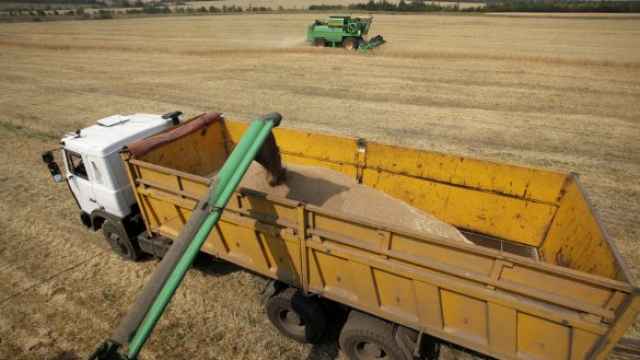LONDON — British scientists have decoded the genetic sequence of wheat — one of the world's oldest and most important crops — in a development they hope could help the global staple meet the challenges of climate change, disease and population growth.
Wheat is grown across more of the world's farmland than any other cereal, and researchers said Friday that they're posting its genetic code to the Internet in the hope that scientists can use it as a tool to improve farmers' harvests. One academic in the field called the discovery "a landmark."
The cracking of wheat's code comes at a time when prices have shot up in the wake of crop failures in Russia, highlighting how the vagaries of world food production can hit import-dependent countries such as Egypt.
"The wheat genome is the holy grail of plant genomes," said Nick Talbot, a professor of biosciences at the University of Exeter, who was not involved in the research. "It's going to really revolutionize how we breed it."
University of Liverpool scientist Neil Hall, whose team cracked the code, said the information could eventually help breeders of varieties of wheat better identify genetic variations responsible for disease resistance, drought tolerance and yield.
Although the genetic sequence remains a rough draft, and additional strains of wheat need to be analyzed for the work to be useful, Hall predicted it would not take long for his work to make an impact in the field.
"Hopefully the benefit of this work will come through in the next five years," he said.
A genome is the full complement of an organism's DNA, complex molecules that direct the formation and function of all living organisms. Sequencing an organism's genome gives unparalleled insight into how it is formed, develops and dies.
Wheat is a relative latecomer to the world of genetic sequencing. This year marks the 10th anniversary of the date the human genome was laid bare. Other crops have had their genetic codes unscrambled within the past few years — rice in 2005, corn in 2009, and soybeans earlier this year.
The reason for the delay in analyzing wheat's genetic code, Hall said, was that the code is massive — far larger than corn or rice and five times the length of the one carried by humans.
One reason for the outsize genome is that strains such as the Chinese spring wheat analyzed by Hall's team carry six copies of the same gene, whereas most creatures carry two. Another is that wheat has a tangled ancestry, tracing its descent from three different species of wild grass.
But sequencing techniques have improved dramatically over the past decade. The process used in this case is called pyrosequencing, which involves extracting DNA, suspending it in fluid, breaking it apart with bursts of gas and using chemical reactions and a high-resolution camera to infer its makeup.
Hall said the machine used enabled his team to analyze a million strands of DNA at a time. The whole process took about a year to complete.
Although the code may yet see use by genetic engineers hoping to craft artificial strains of wheat, Hall was at pains to stress the conventional applications of his work. Until now, breeders seeking to combine the best traits of two strains of wheat would cross the pair, grow the hybrid crop and hope for the best.
Although the process has been used by farmers since wheat was first cultivated 10,000 years ago, Talbot described it as laborious and inefficient.
"Very often we were talking about 10 to 15 years of intensive breeding programs," he said. "We're talking now about doing things in less than five."
Talbot noted that rice cultivation had already benefited from the publication of its genetic code — and led to the development of vitamin-enriched and drought-resistant strains. He said that his own field of specialty, the study of the destructive rice blast fungus, had been revolutionized as a result of having the genome sequence.
Concerns over climate change, water shortages and population growth have loomed in the background for years. New risks include a mutant form of stem rust. The reddish, wind-borne fungus — known to scientists as Ug99 — has devastated wheat crops in places such as Kenya, where up to 80 percent of the wheat in afflicted farmers' fields have been ruined.
Alexander Evans, an expert in resource scarcity issues at New York University, welcomed the announcement as something that would "very helpful" in getting farmers to grow food that will meet those challenges.
But as one British paper hailed the announcement as the most significant breakthrough in wheat farming for 10 millenia, Evans warned against putting too much faith in genetics, saying that reforming the politics and economics of food distribution was easily as important.
"We have to be very careful about saying that science will feed the world," he said.
A Message from The Moscow Times:
Dear readers,
We are facing unprecedented challenges. Russia's Prosecutor General's Office has designated The Moscow Times as an "undesirable" organization, criminalizing our work and putting our staff at risk of prosecution. This follows our earlier unjust labeling as a "foreign agent."
These actions are direct attempts to silence independent journalism in Russia. The authorities claim our work "discredits the decisions of the Russian leadership." We see things differently: we strive to provide accurate, unbiased reporting on Russia.
We, the journalists of The Moscow Times, refuse to be silenced. But to continue our work, we need your help.
Your support, no matter how small, makes a world of difference. If you can, please support us monthly starting from just $2. It's quick to set up, and every contribution makes a significant impact.
By supporting The Moscow Times, you're defending open, independent journalism in the face of repression. Thank you for standing with us.
Remind me later.





